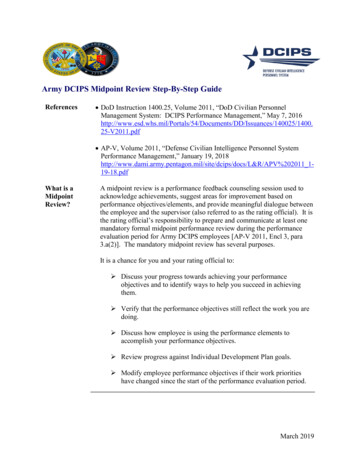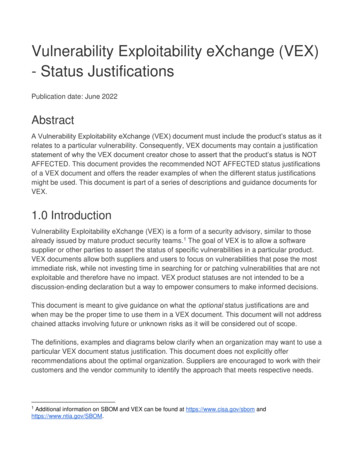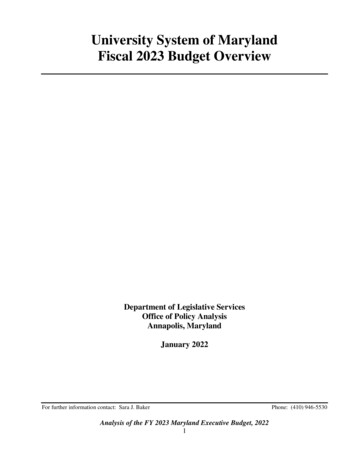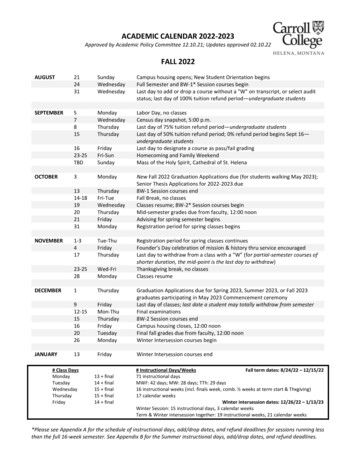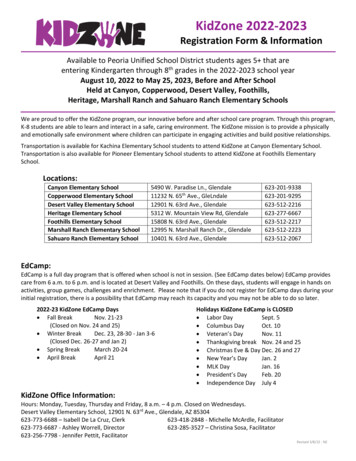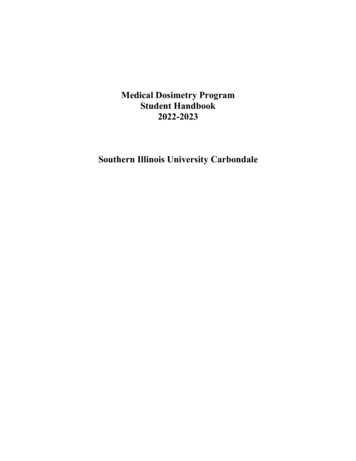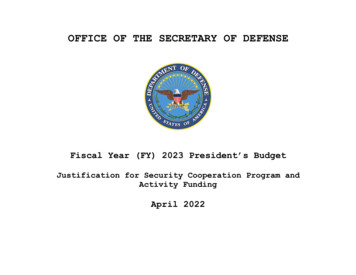
Transcription
OFFICE OF THE SECRETARY OF DEFENSEFiscal Year (FY) 2023 President’s BudgetJustification for Security Cooperation Program andActivity FundingApril 2022
The estimated cost of this report or study for theDepartment of Defense is approximately 15,000 for the2022 Fiscal Year. This includes 4,120 in expenses and 11,000 in DoD labor.Generated on 2022Apr06 RefID: 1-CFFE423
TABLE OF CONTENTSI - DEPARTMENT OF DEFENSE (DOD) SECURITY COOPERATION SUMMARY2Security Cooperation Overview2Categories of Security Cooperation Programs and Activities4II - CATEGORIES OF SECURITY COOPERATION PROGRAMS AND ACTIVITIES8Category 1: Military to Military Engagements8Category 2: Training with Foreign Forces15Category 3: Support to Operations18Category 4: Capacity Building23Category 5: Educational and Training Activities26Category 6: Management, Infrastructure and Workforce Development34Category 7: Humanitarian and Assistance Activities40Category 8: Partner Security Forces Funds43Category 9: Cooperative Threat Reduction46III - FISCAL BREAKDOWN BY AUTHORITY48IV - FISCAL BREAKDOWN BY ORGANIZATION54V - FISCAL BREAKDOWN BY GEOGRAPHIC LOCATION65
Department of Defense (DoD)Security Cooperation (Base Budget)FY 2023 President’s BudgetTHIS PAGE INTENTIONALLY LEFT BLANK1
Department of Defense (DoD)Security Cooperation (Base Budget)FY 2023 President’s BudgetI - Department of Defense (DoD) Security Cooperation SummarySecurity Cooperation OverviewThe 2022 National Defense Strategy (NDS) outlines how mutually beneficial alliances andpartnerships are for the United States (U.S.) and are critical to achieving U.S. objectivesthroughout the world. The United States’ global network of allies and partners is a uniqueAmerican advantage, and Department of Defense (DoD) security cooperation tools are critical tobolster and leverage this network to advance shared interests and values. DoD security cooperationprograms and related activities are a cost-effective means of enhancing the capabilities andcapacity of allies and partners to provide for their own defense, addressing regional securitychallenges, and strengthening relationships that promote mutual interests. Bolstered by theDepartment’s security cooperation efforts, more capable allies and partners contribute toaddressing shared national security challenges effectively alongside or in lieu of the U.S.Title 10, Chapter 16, Section 301 of the U.S. code defines security cooperation as “any program,activity (including an exercise), or interaction of the Department of Defense with the securityestablishment of a foreign country to achieve a purpose as follows: To build and develop allied and friendly security capabilities for self-defense andmultinational operations. To provide the armed forces with access to the foreign country during peacetime or acontingency operation. To build relationships that promote specific United States security interests.”The Department has made significant reforms to align strategic guidance with resource allocation;establish an assessment, monitoring, and evaluation (AM&E) program; and create a comprehensive,common picture of the Department’s budget for security cooperation activities as well as relatedprograms that engage foreign partners. This budget display is a representation of the Department’sprogress to date in achieving security cooperation reform and realizing congressional intent inTitle 10, Chapter 16, security cooperation.2
Department of Defense (DoD)Security Cooperation (Base Budget)FY 2023 President’s BudgetSection 381(a) of Title 10, U.S. Code, requires a consolidated budget of security cooperationprograms and activities be included annually along with the President’s Budget request toCongress. The consolidated budget display is intended to enhance planning and oversight ofsecurity cooperation programs and related activities across the DoD. This annual budget displaydemonstrates how DoD plans, programs, and budgets for programs and activities to align with theDepartment’s strategic objectives.This budget display includes the 3.7 billion requested by the Department for FY 2023 to conductsecurity cooperation programs and activities. It focuses primarily on the funding requested forprograms and activities that will be executed under the authorities in Chapter 16 of Title 10,U.S. Code. It also includes funding requests for non-Chapter 16 programs and activities thatinclude some elements or activities that are consistent with the security cooperation definition,including the Coalition Support Funds, the DoD Cooperative Threat Reduction (CTR) Program, UkraineSecurity Assistance Initiative (USAI), and the Counter-Islamic State of Iraq and Syria (ISIS)Train and Equip Fund (CTEF). This display excludes classified programs, such as programsauthorized under Section 127e of Title 10, U.S. Code, “support of special operations to combatterrorism.” The budget display also excludes Drug Interdiction and Counter-Drug activitiesauthorized under Section 284(c) of Title 10, U.S. Code, “Support for counterdrug activities andactivities to counter transnational organized crime.”In identifying the specific funds allocated to security cooperation, the Department focused oncosts that could be directly tied to security cooperation or similar activities. Many DoDactivities, especially in the Military Services, could be viewed as security cooperation. However,for the purposes of this display, the Department focused on the situations where a securitycooperation program is expected to incur an additional cost beyond what the Department wouldalready be doing. For example, if U.S. forces are planning to conduct a training event and twoobservers from a partner nation are expected to attend, the Department would not reflect the costsof that exercise in this budget display. However, if DoD paid for the travel, lodging andsubsistence of those observers to support attendance, then those costs would be captured in thisdisplay.3
Department of Defense (DoD)Security Cooperation (Base Budget)FY 2023 President’s BudgetCategories of Security Cooperation Programs and ActivitiesThis budget display groups security cooperation programs, related activities, and the respectiveauthorities through which they are executed into nine (9) categories. Categories 1-5 mirror thesubchapters in Chapter 16 of Title 10. The budget display also includes Categories 6-9 as follows:requests that fund the reforms to management and oversight inside the Department (Category 6),humanitarian and assistance activities (Category 7), partner security forces funds forcounterterrorism activities and combating insurgencies (Category 8), and cooperative threatreduction efforts aimed at preventing the proliferation of weapons of mass destruction(Category 9).The nine security cooperation and related activities categories of this display are summarizedbelow:Category 1: Military to Military Engagements – Security cooperation programs and activitiesrelated to the interaction between U.S. military personnel and the national security forces offriendly foreign countries, including the exchange of military personnel, payment of incrementalexpenses, and bilateral and regional cooperation programs.Category 2: Training with Foreign Forces – Security cooperation programs and activities related totraining with military and non-military security forces of friendly foreign countries, as well asthe payment of related training and exercise support.Category 3: Support to Operations – Security cooperation programs and activities that providelogistic support, supplies, services, specialized training, loan of equipment, and reimbursementsto support the conduct of operations in which the U.S. military may or may not be directlyparticipating.Category 4: Capacity Building – Security cooperation programs and activities that build thecapacity of a friendly foreign country’s security forces through the provision of defense articlesand services, including institutional capacity building efforts with international partners.4
Department of Defense (DoD)Security Cooperation (Base Budget)FY 2023 President’s BudgetCategory 5: Educational and Training Activities – Security cooperation programs and activitiesrelated to the participation of foreign personnel in DoD-sponsored education and trainingprograms, including the Regional Centers for Security Studies.Category 6: Management, Infrastructure, and Workforce Development – Activities that encompass theadministration, management, and oversight of security cooperation programs, to include personnel,information technology, facilities, and costs associated with ensuring a qualified securitycooperation workforce, such as the establishment of a certification program.Category 7: Humanitarian Assistance Activities – Security cooperation programs and activitiesassociated with humanitarian and/or civic assistance for friendly foreign countries.Category 8: Partner Security Forces Funds – Security cooperation programs and activitiesassociated with the professionalization, cultivation, and sustainment of partner security forcesin Iraq and Syria, with a focus on preventing the reemergence of ISIS.Category 9: Cooperative Threat Reduction Activities – Title 50 activities focused on working withpartner civilian and military departments to reduce the threat of weapons of mass destruction(WMD) and WMD-related materials to U.S. national interests.The remaining sections of this display provide a breakdown of the Department’s 3.7 billionsecurity cooperation and related activities budget request from various perspectives to meet thecongressional intent of 10 U.S.C. 381(a). Section II details the budget requests for the programsand activities comprising each of the nine categories. Section III displays the Department’sprogram requests by authority. The programs and authorities are displayed separately because someDoD programs execute activities under multiple authorities, thereby preventing a one-to-onecorrelation between program and authority. Section IV provides the Department’s request based ongeographic region, defined here as combatant command (CCMD) area of responsibility (AOR).The FY 2023 budget request eliminates the use of Direct War and Enduring terms for the formerOverseas Contingency Operations funding and shifts all requirements previously funded by Direct5
Department of Defense (DoD)Security Cooperation (Base Budget)FY 2023 President’s BudgetWar and Enduring costs to Base (Overseas Operations). All 2023 data provided in this exhibitreflects the amount the Department requested for FY 2023 whereas the data provided in this exhibitfor 2022 reflects enacted values in the FY 2022 Defense Budget.6
Department of Defense (DoD)Security Cooperation (Base Budget)FY 2023 President’s BudgetSecurity Cooperation Budget OverviewFY 2023 (dollars in thousands)CategoryOverseasOperationsTotal Base11: Military to Military Engagements106,730--106,7302: Training with Foreign Forces158,759--158,7595,442550,000555,4424: Capacity Building547,5881,145,3321,692,9205: Educational and Training Activities146,790--146,79094,955--94,9557: Humanitarian and Assistance Activities114,800--114,8008: Partner Security Forces Funds541,692--541,6929: Cooperative Threat Reduction341,598--341,598TOTAL 2,058,3551,695,3323,753,6873: Support to Operations6: Management, Infrastructure and WorkforceDevelopment1BaseTotal Base includes Base and Overseas Operations7
Department of Defense (DoD)Security Cooperation (Base Budget)FY 2023 President’s BudgetII - Categories of Security Cooperation Programs and ActivitiesCategory 1: Military to Military EngagementsMilitary-to-military engagements are a key relationship-building tool for the Department. Theseprograms include exchange of military personnel, payment of incremental expenses and bilateral andregional cooperation programs. Title 10, Chapter 16 provides the Department the authority toconduct nonreciprocal exchanges and authorizes exchanges with non-defense security ministries aswell as regional and international security organizations. The FY 2017 NDAA also consolidated foursimilar regional authorities that permit the payment of personnel expenses, and made some aspectsof those previous authorities global. These authorities are limited to developing countries exceptin exceptional circumstances.FY 2023 (dollars in thousands)Program / ActivityAfrican Partnership FlightAfrican Partnership StationMilitary to Military EngagementsPacific PartnershipSouthern PartnershipState Partnership Program (National Guard)TOTAL Military to Military EngagementsOverseasOperationsBaseTotal 50--5030,441--30,441106,730--106,7308
Department of Defense (DoD)Security Cooperation (Base Budget)FY 2023 President’s BudgetAFRICAN PARTNERSHIP FLIGHT:The U.S. Air Forces in Europe, Air Forces Africa (USAFE-AFAFRICA) Partnership Flight programincludes multilateral military-to-military engagements with African and/or European Air Forcepartners. Partnership flights provide fora to discuss best practices and lessons learned in theair enterprise to facilitate capability and capacity development. Partnership flights areprimarily hosted in U.S. Africa Command or U.S. European Command partner nations and attended byregional partners with similar capability requirements to meet aligned strategic objectives. Thesesecurity cooperation engagements strengthen U.S. strategic partnerships with key countries in boththeaters, share best practices on aviation related topics, and demonstrate best practices inlimited practical application (capstone) events. Simultaneously, these engagements buildpartnerships, enhance regional cooperation and interoperability, and set the foundation for newcapabilities and capacity.(dollars in thousands)BaseTOTAL AFRICAN PARTNERSHIP FLIGHTFY 2022FY 20237527657527659
Department of Defense (DoD)Security Cooperation (Base Budget)FY 2023 President’s BudgetAFRICAN PARTNERSHIP STATION:Africa Partnership Station (APS) is the U.S. Naval Forces Africa’s (NAVAF) flagship maritimesecurity cooperation program. APS focuses on strengthening maritime security and ensuring U.S.access and freedom of operation by promoting the U.S. as the partner of choice for African naviesand coast guards. APS supports U.S. efforts to improve maritime domain awareness and maintenancecapabilities of African partner forces, as well as conducting senior leadership conferences, stafftalks, regional information-sharing efforts (such as the Yaoundé and Djibouti Codes of Conduct),the annual Maritime Security Working Group (MSWG), and assessments to inform future capacitybuilding programs. Additionally, APS supports travel of U.S. personnel to survey African ports inorder to conduct ship visits and prepare for theater security cooperation engagement.U.S. Africa Command (AFRICOM) and NAVAF require APS funds to conduct activities with internationalpartners and governmental/non-governmental organizations that enhance African partner nations’capability to assure maritime security within their exclusive economic zones. These activitiessupport annual maritime action plans that includes both international and interagency partners’activities. Maritime Action Plans for each partner nation support both the AFRICOM Campaign Plan,NAVAF Country Action Plans, and Integrated Country Strategies.(dollars in thousands)BaseTOTAL AFRICAN PARTNERSHIP STATIONFY 2022FY 20234,6434,7904,6434,79010
Department of Defense (DoD)Security Cooperation (Base Budget)FY 2023 President’s BudgetMILITARY TO MILITARY ENGAGEMENTS:Military-to-military engagements deepen interoperability, develop and exercise joint operationalconcepts, and demonstrate capabilities, including for the purposes of deterrence or reassurance.Through a variety of exchanges and bilateral and regional cooperation programs, these engagementsenable partners to develop the capabilities required to play critical roles in the execution ofcontingency operations that either (1) enable U.S. forces to prevail, or (2) mitigate risks toU.S. forces. Those roles may include specific missions within an operation, contributing forces tocoalition operations, or providing access and infrastructure, if necessary, to enable U.S. orcoalition operations.(dollars in thousands)BaseTOTAL MILITARY TO MILITARY ENGAGEMENTSFY 2022FY 202349,50163,88449,50163,88411
Department of Defense (DoD)Security Cooperation (Base Budget)FY 2023 President’s BudgetPACIFIC PARTNERSHIP:Pacific Partnership is the largest annual multilateral humanitarian and civic assistance anddisaster relief (HCA/DR) preparedness mission conducted in the Indo-Pacific. It fosterscoordination and cooperation in areas such as medical readiness, disaster resilience, and preevent preparation for man-made and natural disasters. FY 2022 represents the Pacific Partnership’s17th year, and it continues to enhance regional partnerships and host nation relationships throughcivil-military cooperation, medical exchanges, engineering exchanges, and advancing initiativeslike the Women, Peace, and Security Act through side-by-side partnering and intergovernmentalagency coordination.(dollars in thousands)BaseTOTAL PACIFIC PARTNERSHIPFY 2022FY 20236,6006,8006,6006,80012
Department of Defense (DoD)Security Cooperation (Base Budget)FY 2023 President’s BudgetSOUTHERN PARTNERSHIP STATION:Southern Partnership Station (SPS) is conducted by U.S. Naval Forces Southern Command(USNAVSO)/U.S. 4th Fleet in support of partner nation engagements through the use of AdaptiveForce Packages (AFPs). SPS employs AFPs within a regional area of interest while forming long-termtactical and operational cooperative relationships with partner maritime forces. These activitiesfocus primarily on building partner nation capability and capacity, improving U.S.interoperability in support of shaping operations, and increasing regional maritime securitythrough the cooperative efforts of joint, combined and interagency partners. SPS deployments caninclude the use of: Oceanographic survey forces; Expeditionary Fast Transport to execute counterthreat network and theater security cooperation (TSC) missions; an amphibious ship to conductmultilateral naval and amphibious operations that enhance partner nation interoperability andregional maritime security capabilities; and other various task organized detachments to conductTSC activities that strengthen U.S. regional credibility, while also improving U.S. and partnernation tactics, techniques, and procedures.(dollars in thousands)BaseTOTAL SOUTHERN PARTNERSHIP STATIONFY 2022FY 20235050505013
Department of Defense (DoD)Security Cooperation (Base Budget)FY 2023 President’s BudgetSTATE PARTNERSHIP PROGRAM (NATIONAL GUARD):DoD's State Partnership Program (SPP) contributes to U.S. national security through conductingmilitary-military engagements and building long-term relationships globally in direct support ofthe Geographic Combatant Commanders’ theater campaign plans and U.S. Chief of Mission integratedcountry strategies. SPP activities are conducted in direct support of the Geographic CombatantCommanders’ theater campaign plans and U.S. Chief of Mission integrated country strategies. SPPactivities promote mutual understanding, interoperability, and readiness of National Guard forces;support combatant command missions; and build enduring relationships with partner nations. Fundingsupports the National Guard's ability to engage in security cooperation activities with 93 partnernations. These activities include senior leader engagements, subject matter expert exchanges, andconferences, workshops, and exercise participation. This program supports the additional man-daysand operations and maintenance funding required to plan, coordinate, and execute these SPPactivities. The nearly 30 million decrease from FY 2022 enacted to the FY 2023 request is due toa 19 million FY 2022 Congressional enhancement in the FY 2022 Consolidated Appropriations Act.Full details of completed State Partnership Program activities for prior years is reported asrequired under 10 U.S.C. Section 386.(dollars in thousands)BaseTOTAL STATE PARTNERSHIP PROGRAM (NATIONAL GUARD)FY 2022FY 202360,40730,44160,40730,44114
Department of Defense (DoD)Security Cooperation (Base Budget)FY 2023 President’s BudgetCategory 2: Training with Foreign ForcesTraining with foreign forces builds relationships with friendly foreign forces, improvesinteroperability, and contributes to building the capability of key allies through exposure toU.S. tactics, techniques, and procedures. This training enhances the ability of partners toparticipate in current operations, either alongside of or in lieu of U.S. forces.Simultaneously, such training activities contribute to mission-essential tasks for U.S. forces andimprove their ability to execute campaign plans and achieve strategic objectives.FY 2023 (dollars in thousands)Program / ActivityBaseJoint Combined Exchange TrainingTraining with Friendly Foreign CountriesTOTAL Training with Foreign ForcesOverseasOperationsTotal 15
Department of Defense (DoD)Security Cooperation (Base Budget)FY 2023 President’s BudgetJOINT COMBINED EXCHANGE TRAINING:The Joint Combined Exchange Training (JCET) program is designed to train U.S. Special OperationsForces (SOF) in their mission-essential tasks, particularly foreign internal defense andunconventional warfare. They are short duration overseas deployments to train with military andother security forces of friendly foreign nations. They are intended to build U.S. SOF capabilityto conduct combined operations in an unfamiliar environment, develop language skills, and gainfamiliarity with regional and local geography and culture. Incidental benefits to this trainingprogram include building and maintaining military-to-military contacts; gaining regional accesswith minimal footprint; improving interoperability between U.S. SOF and partner nation forces,and; enhancing partner nation forces’ counterterrorism abilities.(dollars in thousands)BaseTOTAL JOINT COMBINED EXCHANGE TRAININGFY 2022FY 202351,12855,05351,12855,05316
Department of Defense (DoD)Security Cooperation (Base Budget)FY 2023 President’s BudgetTRAINING WITH FRIENDLY FOREIGN COUNTRIES:Training with friendly foreign country programs consist of exercises or engagements designed withthe primary purpose of benefitting general purpose U.S. forces, while also providing a range ofbenefits to allies and partners. Training with friendly foreign countries supports the developmentof ally and partner military capabilities and enables them to contribute to the achievement ofU.S. strategic priorities. This training provides access to foreign countries, in which the U.S.may need to operate, improves interoperability with allies and partners who may contribute tofuture coalition operations, and reinforces the U.S. unit’s mission essential tasks.As part of global steady-state operations, DoD seeks to enable partners to carry out a range ofspecific missions, such as counterterrorism operations, disruption of drug trafficking and otherillicit trafficking networks, maritime interdiction, countering weapons of mass destruction, andhumanitarian assistance/disaster response operations, in order to promote regional stability andprevent localized threats from growing to require U.S. involvement. Training with friendly forcesbuilds relationships that promote specific U.S. security interests.(dollars in thousands)BaseTOTAL TRAINING WITH FRIENDLY FOREIGN COUNTRIESFY 2022FY 202396,176103,70696,176103,70617
Department of Defense (DoD)Security Cooperation (Base Budget)FY 2023 President’s BudgetCategory 3: Support to OperationsSupport to operations includes two key roles for partners and allies: Supporting U.S. operationsand conducting operations in lieu of U.S. forces. Ultimately, much of the security cooperationenterprise aims to develop the capabilities, relationships, and interoperability that enablecountries to fill these two roles. Support to operations encompasses overarching types ofassistance: Reimbursable support to key cooperating nations for support rendered that contributed to U.S.operations to counter the Islamic State of Iraq and Syria (ISIS); Non-reimbursable logistic support, supplies, and services (LSSS); specialized training; and loanof equipment to partners to enable support to U.S. operations; Non-reimbursable transportation,sustainment, subsistence, and medical assistance for partner forces supporting U.S. operations tocounter ISIS; Reimbursable support to certain partners for expenses incurred to increase security, and sustainincreased security, along their border; and Provide LSSS to countries that are engaged in operations that are in the national securityinterest of the United States, in which the U.S. may not be participating.FY 2023 (dollars in thousands)Program / ActivityOverseasOperationsBaseTotal BaseBorder Security--520,000520,000Coalition Support Program--30,00030,000Lift and t to conduct of OperationsTOTAL Support to Operations18
Department of Defense (DoD)Security Cooperation (Base Budget)FY 2023 President’s BudgetBORDER SECURITY:Section 9026 of the FY 2021 Defense Appropriations Act combined with Section 1226 of the NationalDefense Authorization Action of FY 2008, as amended provides support to key allies and partnernations on a reimbursable basis for expenses incurred to increase security and sustain increasedsecurity along their borders adjacent to conflict areas. This assistance serves to degrade thefree movement of ISIS and other violent extremist organizations, illicit weapons, narcotics aswell as other forms of smuggling in an effort to promote greater regional security. The enactmentof Section 9026 in FY 2021 consolidated border security funding previously included in theCoalition Support Funds (CSF) and the Counter-ISIS Train and Equip Fund (CTEF) appropriations.The 150M increase from FY 2022 enacted to the FY 2023 request reflects an increase in forecastedclaims from U.S. Central Command partners.(dollars in thousands)Base (Direct War)Base (Overseas Operations)TOTAL BORDER SECURITYFY 2022FY 2023370,000----520,000370,000520,00019
Department of Defense (DoD)Security Cooperation (Base Budget)FY 2023 President’s BudgetCOALITION SUPPORT PROGRAM:Coalition Support Funds (CSF) serve as a valuable resource for the Department to provideassistance to key cooperating nations that have committed forces to assist in U.S. militaryoperations to counter the Islamic State of Iraq and Syria (ISIS) and to finish reimbursingpartners who previously supported U.S. operations in Afghanistan. The forces these coalitionpartners provide is essential to the success of U.S. military operations, and without directassistance, these partners would not be able to participate; thus, requiring an increase in U.S.forces. The CSF are available to reimburse key cooperating nations for allowable expensesincurred while supporting U.S. military operations; allow for the procurement and provision ofspecialized training, supplies, and specialized equipment on a non-reimbursable basis to coalitionforces supporting U.S. led operations to Counter ISIS under the Coalition Readiness SupportProgram (CRSP). The deployed forces serve as force multipliers and reduce requirements for U.S.Armed Forces. The FY 2023 request represents a 20 million decrease in Coalition Support due tothe continued suspension of U.S. security assistance to Pakistan and the U.S. withdrawal fromAfghanistan.(dollars in thousands)Base (Direct War)Base (Overseas Operations)TOTAL COALITION SUPPORT PROGRAMFY 2022FY 202350,000----30,00050,00030,00020
Department of Defense (DoD)Security Cooperation (Base Budget)FY 2023 President’s BudgetLIFT AND SUSTAIN:Lift and Sustain provides non-reimbursable subsistence, sustainment, medical, and transportationassistance to eligible coalition military formally supporting military operations in Afghanistanand to counter the Islamic State of Iraq and Syria (ISIS). U.S. support enabled these forces toremain in theater to contribute to contingency operations. Without this assistance, coalitionpartners that lack the financial means would not have been able to participate; thus, requiring anincrease in U.S. forces. Following the drawdown of forces in Afghanistan, the Department is notrequesting Lift and Sustain funding in FY 2023 and moving forward.(dollars in thousands)Base (Direct War)TOTAL LIFT AND SUSTAINFY 2022FY 2023150,000--150,000--21
Department of Defense (DoD)Security Cooperation (Base Budget)FY 2023 President’s BudgetSUPPORT TO CONDUCT OF OPERATIONS:Military assistance provided by friendly foreign countries significantly contributes to globalU.S. military operations in advancing shared interests. The Secretary of Defense may provide up to 450 million annually of non-reimbursable logistic support, supplies, and services (LSSS) tofriendly foreign forces participating in combined operations with the United States. This mayinclude the procurement of equipment, specialized training, and small-scale construction focusedon enhancing capabilities and promoting interoperability. Partner contributions under the Section331 authority have reduced requirements for U.S. forces, enhanced interoperability, and providedenhanced credibility and effectiveness against shared security threats.(dollars in thousands)BaseTOTAL SUPPORT TO CONDUCT OF OPERATIONSFY 2022FY 20235,5315,4425,5315,44222
Department of Defense (DoD)Security Cooperation (Base Budget)FY 2023 President’s BudgetCategory 4: Capacity BuildingCapacity building programs form the core of the Department’s security cooperation activities andinclude training and equipping of foreign forces along with the accompanying institutionalcapacity building, human rights, and law of armed conf
7kh hvwlpdwhg frvw ri wklv uhsruw ru vwxg\ iru wkh 'hsduwphqw ri 'hihqvh lv dssur[lpdwho\ iru wkh )lvfdo hdu 7klv lqfoxghv lq h[shqvhv dqg

